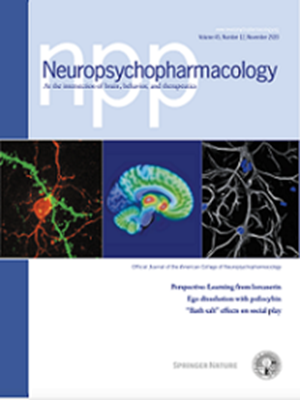DRN-SNc serotonergic circuit drives stress-induced motor deficits and Parkinson’s disease vulnerability
IF 6.6
1区 医学
Q1 NEUROSCIENCES
引用次数: 0
Abstract
Stress is a recognized risk factor for Parkinson’s disease (PD), but the mechanisms by which stress exacerbates PD symptoms through the serotonergic system are not fully understood. This study investigates the role of serotonergic (5-HT) neurons in the dorsal raphe nucleus (DRN) in mediating stress-induced motor deficits and PD progression. Acute and chronic stress were induced in mice using an elevated platform (EP) and combined with MPTP administration to model early-stage PD. Acute EP stress caused transient motor deficits and significant activation of DRN5-HT neurons projecting to substantia nigra compacta (SNc) dopaminergic (DA) neurons. Manipulating the DRN-SNc pathway with optogenetics and chemogenetics confirmed its critical role in stress-induced motor deficits. Activation of the SNc 5-HT2C receptor with an agonist replicated these deficits, while receptor inhibition prevented them, underscoring its importance. Chronic EP stress worsened MPTP-induced deficits and caused significant SNcDA neurons loss, suggesting it accelerates PD progression. Prolonged chemogenetic inhibition of the DRN-SNc circuit mitigated chronic stress effects in MPTP-treated mice. These findings highlight the crucial role of the DRN-SNc serotonergic circuit and 5-HT2C receptors in stress-related motor deficits, suggesting potential targets for therapies aimed at treating both stress-related motor disorders and Parkinson’s disease.

DRN-SNc血清素能回路驱动应激诱导的运动障碍和帕金森病易感性。
压力是帕金森病(PD)的一个公认的危险因素,但压力通过血清素能系统加重PD症状的机制尚不完全清楚。本研究探讨了中隔背核(DRN)中5-羟色胺能(5-HT)神经元在介导应激性运动缺陷和PD进展中的作用。采用升高平台(EP)诱导小鼠急性和慢性应激,并联合MPTP给药,建立早期PD模型。急性EP应激引起短暂性运动障碍和DRN5-HT神经元的显著激活,DRN5-HT神经元投射到黑质致密(SNc)多巴胺能(DA)神经元。通过光遗传学和化学遗传学对DRN-SNc通路的操纵证实了其在应激性运动缺陷中的关键作用。用激动剂激活SNc 5-HT2C受体复制了这些缺陷,而受体抑制阻止了这些缺陷,强调了其重要性。慢性EP应激加重mptp诱导的缺陷,并导致SNcDA神经元显著丢失,提示其加速PD进展。在mptp处理的小鼠中,DRN-SNc回路的长时间化学发生抑制减轻了慢性应激效应。这些发现强调了DRN-SNc 5-羟色胺能回路和5-HT2C受体在应激相关运动缺陷中的关键作用,提示了治疗应激相关运动障碍和帕金森病的潜在靶点。
本文章由计算机程序翻译,如有差异,请以英文原文为准。
求助全文
约1分钟内获得全文
求助全文
来源期刊

Neuropsychopharmacology
医学-精神病学
CiteScore
15.00
自引率
2.60%
发文量
240
审稿时长
2 months
期刊介绍:
Neuropsychopharmacology is a reputable international scientific journal that serves as the official publication of the American College of Neuropsychopharmacology (ACNP). The journal's primary focus is on research that enhances our knowledge of the brain and behavior, with a particular emphasis on the molecular, cellular, physiological, and psychological aspects of substances that affect the central nervous system (CNS). It also aims to identify new molecular targets for the development of future drugs.
The journal prioritizes original research reports, but it also welcomes mini-reviews and perspectives, which are often solicited by the editorial office. These types of articles provide valuable insights and syntheses of current research trends and future directions in the field of neuroscience and pharmacology.
 求助内容:
求助内容: 应助结果提醒方式:
应助结果提醒方式:


